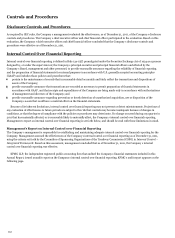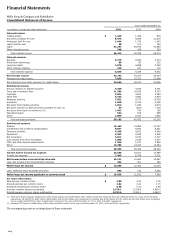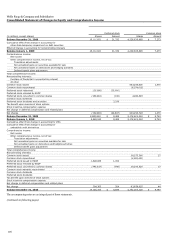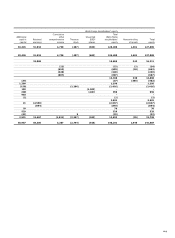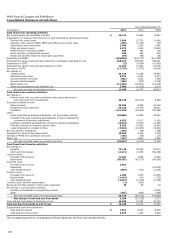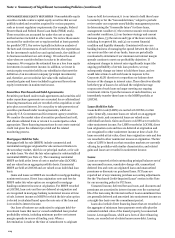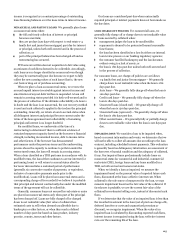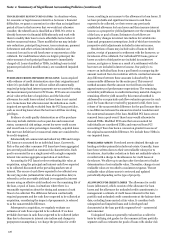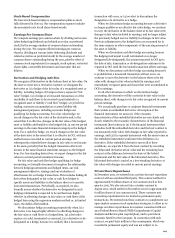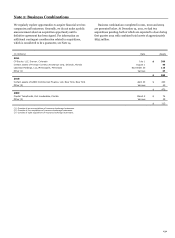Wells Fargo 2011 Annual Report Download - page 123
Download and view the complete annual report
Please find page 123 of the 2011 Wells Fargo annual report below. You can navigate through the pages in the report by either clicking on the pages listed below, or by using the keyword search tool below to find specific information within the annual report.
See the Glossary of Acronyms at the end of this Report for terms used throughout the Financial Statements and related Notes of this
Form 10-K.
Note 1: Summary of Significant Accounting Policies
Wells Fargo & Company is a diversified financial services
company. We provide banking, insurance, trust and
investments, mortgage banking, investment banking, retail
banking, brokerage, and consumer and commercial finance
through banking stores, the internet and other distribution
channels to consumers, businesses and institutions in all 50
states, the District of Columbia, and in other countries. When we
refer to “Wells Fargo,” “the Company,” “we,” “our” or “us,” we
mean Wells Fargo & Company and Subsidiaries (consolidated).
Wells Fargo & Company (the Parent) is a financial holding
company and a bank holding company. We also hold a majority
interest in a real estate investment trust, which has publicly
traded preferred stock outstanding.
Our accounting and reporting policies conform with U.S.
generally accepted accounting principles (GAAP) and practices
in the financial services industry. To prepare the financial
statements in conformity with GAAP, management must make
estimates based on assumptions about future economic and
market conditions (for example, unemployment, market
liquidity, real estate prices, etc.) that affect the reported amounts
of assets and liabilities at the date of the financial statements and
income and expenses during the reporting period and the related
disclosures. Although our estimates contemplate current
conditions and how we expect them to change in the future, it is
reasonably possible that actual conditions could be worse than
anticipated in those estimates, which could materially affect our
results of operations and financial condition. Management has
made significant estimates in several areas, including allowance
for credit losses and purchased credit-impaired (PCI) loans
(Note 6), valuations of residential mortgage servicing rights
(MSRs) (Notes 8 and 9) and financial instruments (Note 17),
liability for mortgage loan repurchase losses (Note 9) and
income taxes (Note 21). Actual results could differ from those
estimates.
Accounting Standards Adopted in 2011
In first quarter 2011, we adopted certain provisions of
Accounting Standards Update (ASU or Update) 2010-6,
Improving Disclosures about Fair Value Measurements.
ASU 2010-06 amends the disclosure requirements for fair
value measurements. Companies are required to disclose
significant transfers in and out of Levels 1 and 2 of the fair value
hierarchy. This Update also clarifies that fair value measurement
disclosures should be presented for each asset and liability class,
which is generally a subset of a line item in the statement of
financial position. In the rollforward of Level 3 activity,
companies must present information on purchases, sales,
issuances, and settlements on a gross basis rather than on a net
basis. Companies should also provide information about the
valuation techniques and inputs used to measure fair value for
both recurring and nonrecurring instruments classified as either
Level 2 or Level 3. In first quarter 2011, we adopted the
requirement for gross presentation in the Level 3 rollforward
with prospective application. The remaining provisions were
effective for us in first quarter 2010. Our adoption of this Update
did not affect our consolidated financial statement results since
it amends only the disclosure requirements for fair value
measurements.
In third quarter 2011, we adopted the following new
accounting guidance:
Certain provisions of ASU 2010-20, Disclosures about the
Credit Quality of Financing Receivables and the Allowance
for Credit Losses; and
ASU 2011-02, A Creditor’s Determination of Whether a
Restructuring is a Troubled Debt Restructuring.
ASU 2010-20 requires enhanced disclosures for the allowance
for credit losses and financing receivables, which include certain
loans and long-term accounts receivables. Companies are
required to disaggregate credit quality information and roll
forward the allowance for credit losses by portfolio segment.
Companies must also provide supplemental information on the
nature and extent of troubled debt restructurings (TDRs) and
their effect on the allowance for credit losses. We adopted the
new disclosure requirements for TDRs in third quarter 2011 with
retrospective application to January 1, 2011. The remaining
provisions were effective for us in fourth quarter 2010.
Our
adoption of this Update did not affect our consolidated financial
statement results since it amends only the disclosure
requirements for financing receivables and the allowance for
credit losses.
ASU 2011-02 provides guidance clarifying under what
circumstances a creditor should classify a restructured receivable
as a TDR. A receivable is a TDR if both of the following exist: 1) a
creditor has granted a concession to the debtor, and 2) the
debtor is experiencing financial difficulties. This Update clarifies
that a creditor should consider all aspects of a restructuring
when evaluating whether it has granted a concession, which
include determining whether a debtor can obtain funds from
another source at market rates and assessing the value of
additional collateral and guarantees obtained at the time of
restructuring. This Update also provides factors a creditor
should consider when determining if a debtor is experiencing
financial difficulties, such as probability of payment default and
bankruptcy declarations. This guidance was effective for us in
third quarter 2011 with retrospective application to
January 1, 2011. Our adoption of this Update did not have a
material effect on our consolidated financial statements.
In fourth quarter 2011, we early adopted ASU 2011-08,
Testing Goodwill for Impairment.
121



